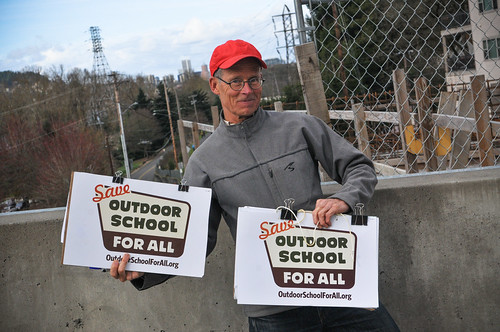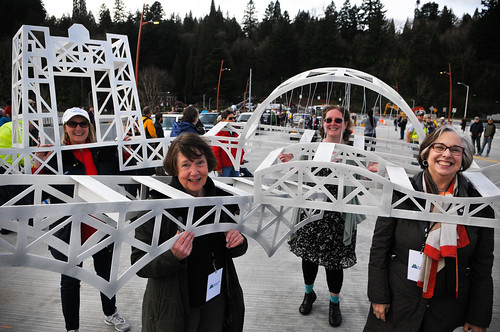For the second time in less than a year Portlanders got the chance to celebrate the opening of a new bridge over the Willamette River.
“We’re going to need to find a way to invade Clackamas County to recoup some of our costs; but seeing they have more guns than we do we should probably come up with a well thought out plan before we do anything.”
— Steve Novick, Portland City Commissioner
Thousands of people flocked to Sellwood on Saturday to get their first glimpse of the bridge that bears the neighborhood’s name. Expected to open to traffic on March 1st, the new $300 million Sellwood Bridge will replace a bruised and battered span that opened 91 years ago. Yesterday’s celebration was an opportunity for Multnomah County to say “thank you” to the community and its many partners on the project. It was also a huge party high above the river on an unseasonably warm and sunny day that featured live music, activity booths, a parade, a blessing from Native Americans and, of course, speeches from various dignitaries.
Before the ribbon was officially cut (by what appeared to be the young daughter of Multnomah County Commissioner Chair Deborah Kafoury), local elected officials had a final chance to put their stamp on the project. Most of the speeches were entirely predictable. There were dozens of glowing reviews of the bridge and the decade or so of political and public processes it took to get it built.
But Portland City Commissioner Steve Novick was having none of that.
Novick used his time to point out his disappointment in Clackamas County, a region notably absent from yesterday’s festivities — and from the project’s budget. After listing financial contributions from the city of Portland ($73 million), state ($35 million), federal government ($17 million) and Multnomah County ($170 million), Novick said (in jest) he plans to invade Clackamas County to get their share. “And Clackamas County, where over 70 percent of trips over the bridge start or end, contributed zero,” he said. “So we’re going to need to find a way to invade Clackamas County to recoup some of our costs; but seeing they have more guns than we do we should probably come up with a well thought out plan before we do anything.”
Not only did Clackamas County shirk financial responsibilities for the new bridge, the idea of tolling users of the bridge never gained traction. But that’s all water under the bridge. With the political battles in the rear-view mirror, Saturday was a time to celebrate and take a closer look at the bridge’s design.
The total width of the new bridge is 64-feet: 24-feet for two standard vehicle lanes, 13-feet for two bicycle-only lanes, and 24-feet for two biking and walking paths. The sidewalks got a lot of attention on Saturday. Not only are they the best place to see the view but they stand in stark contrast to single three-foot sidewalk we’ve all been dealing with on the old bridge for so many years.
Here are my photos and a few more thoughts from the event…
The new bridge will be a magnet for cycling: It’s surrounded by popular paths and training routes, it’s flat, it connects well to adjacent paths, it makes a fun loop with the new Tilikum Crossing Bridge, and it’ll be free from the stress of central city traffic….
Volunteer and member of the County’s Bicycle and Pedestrian Advisory Committee, Andrew Holtz sporting one of the cool aprons made just for the event…
The paths at the eastern end of the bridge won’t be fully completed until November….
Look who we spotted gaining signatures for a petition. None other than Bicycle Transportation Alliance founder and former Metro Councilor Rex Burkholder…
Advertisement
Quite an improvement over the decrepit old bridge huh?!
ODOT Director Matt Garrett was on hand. I asked him about recent criticisms from former Metro President David Bragdon but he didn’t want to talk about it…
These “Bridgettes” made my day…
This is City Commissioner of Transportation Steve Novick riding in a car during the parade…
County Commissioner and Portland mayoral candidate Jules Bailey also hopped in a car for the parade…
I need to get something off my chest about the parade: This bridge has more room dedicated to cycling than to driving — yet the parade included zero bicycles. Instead, all these wonderful people who were enjoying a carfree day had to stand and breathe toxic emissions from a line of slowly idling cars. Not including bicycles in the parade was a huge missed opportunity! (see next photo for more)
I ran into prolific bike and neighborhood advocate Roger Averbeck. Before I could finish my sentence about no bikes in the parade he was already planning to jump in. I think he was as annoyed as I was about it. Then I prodded two more women on bikes who were watching the parade to join him!
A rare sighting of Jeff Smith, who’s well into his third decade as a bicycle planning and program specialist with the Portland Bureau of Transportation…
Barb Gribskov said she definitely plans on riding in the bike lane and not on the path…
Commissioner Novick’s Transportation Policy Advisor Timur Ender (left) and Althea Mickiewicz were some of the first bike wheels on the new bridge…
Instead of a corridor used solely for moving people across the river, the new bridge is a place. It feels more approachable and human-scaled than any other of Portland’s main bridges. Wide belvederes on both sides will be places where people can sit and eat lunch or have a relaxed conversation with a friend.
It remains to be seen how bicycle riders will use the bridge. Unlike any other Willamette River bridge riders will be able to choose between sharing the path with the people on foot or sharing the bridge deck with people in cars. I asked several people Saturday which one they’d choose and the responses weren’t surprising. People decked out in lycra said they’d take the bike lane while riders in casual clothes said they’d opt for the path. One mom who was with her pre-teen children said she wasn’t sure where she’d take her family. “We’ll have to wait and see,” she said, “It depends on how safe it feels.”

There will be a lot of waiting and seeing once the bridge fully opens in November. Two of the bicycling-related elements we expected to see will not be implemented: the green-colored bicycle-only lanes and the pavement markings (similar to ones on the Hawthorne Bridge) that are intented to separate bicycling and walking on the path. As we reported in July 2012, the final adopted design came with green concrete that would intended to make it clear to auto users that the curbside bike lane was not for parking or passing. “The concrete will be stained this dark green color,” a county spokesperson said at the time, “Our main goal is to indicate to drivers that the shoulder is a bike lane and that bicyclists have a right to be there.”
But according to a member of the the County’s Bicycle and Pedestrian Citizen’s Advisory Committee, the bridge will open without the green bike lanes or pavement markings on the path. Committee member Andrew Holtz shared in an interview this morning that when County staff asked them about the green coloring at a recent meeting, “We thought, let’s just see how it goes. Some sort of paint or coloring could be added later if there appears to be a big problem.” Holtz and other committee members don’t think encroachments into the bike lane will be a big issue because the bike lanes aren’t wide enough to use for passing. “There wasn’t a clear sense from the committee that it [the green paint] was necessarily any safer.” Holtz added that if people do drive and/or park in the bike lanes and if congestion on the path becomes an issue they’ll add the markings later.
It’s worth noting that back in July 2012, right before a final vote on the bridge design, the County proposed cost-cutting measures. One of those was to eliminate the $81,000 for “bike/ped surface treatments” that included the green coloring and markings. Thankfully that proposal died after it was fiercely opposed by then Mayor Sam Adams and the Bicycle Transportation Alliance. We plan on digging more into this and will have an update on the final design later this week.
The County expects the bridge to open to daily traffic either tomorrow (March 1) or Wednesday. Please note, while the main deck will be open, the bridge won’t be fully open until November. All cycling and walking traffic will share the northside path, which will narrow to six feet as it approaches the east end of the bridge until it’s fully built in October. The new section of the Westside Greenway Trail from the bridge to Willamette Park is expected to open in April.
UPDATE, 2:27pm: County spokesman Mike Pullen says that while green color will not be used on the bike lanes, there will be a two-foot buffer zone between the bike lanes and the center lanes on the bridge. “Our bike-ped committee believed that with this buffer zone added and the traffic lanes narrowed slightly to slow motor vehicle traffic, the green lane was not needed.” Pullen added that, “We are still exploring methods to add the green color to the full length of the bike lanes on the bridge.” As for the pavement markings on the path, Pullen says those will be added to the path once final striping is completed.
— Jonathan Maus, (503) 706-8804 – jonathan@bikeportland.org
BikePortland can’t survive without paid subscribers. Please sign up today.


















